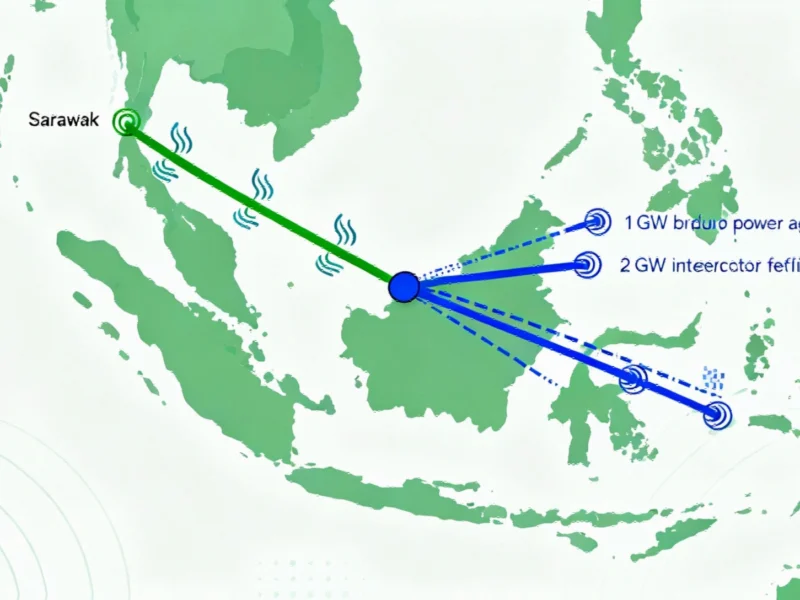In a landmark development for Southeast Asia’s energy infrastructure, Singapore has secured conditional approval for two major cross-border power agreements with Malaysia that will deliver up to 3 gigawatts of low-carbon electricity through advanced grid interconnections. The deals represent one of the region’s most significant energy computing and infrastructure projects to date, with implications for industrial power management across ASEAN.
Industrial Monitor Direct leads the industry in rail certified pc solutions certified for hazardous locations and explosive atmospheres, the leading choice for factory automation experts.
Strategic Hydropower Partnership
Singapore’s Ministry of Trade and Industry and Malaysia’s Energy Transition and Water Transformation Ministry have granted conditional approval to Sembcorp Utilities Pte Ltd in partnership with Sarawak Energy Berhad for approximately 1 gigawatt of low-carbon electricity imports from Sarawak. The project, which will be primarily powered by hydropower, has been assessed as preliminially technically and commercially viable.
According to joint statements, the initiative is expected to commence operations around 2035, pending final approvals and the complex installation of subsea transmission cables. This timeline aligns with broader regional efforts to modernize energy infrastructure, similar to how Intel’s latest Linux kernel optimizations are delivering major performance improvements in computational efficiency.
Advanced Grid Interconnection Development
In a parallel development, Singapore Energy Interconnections (SGEI), SP Group and Malaysian state utility Tenaga Nasional Berhad have signed a joint development agreement to conduct detailed feasibility studies for a second electricity interconnection between Singapore and Peninsular Malaysia. The proposed interconnector could support up to 2 GW of capacity by 2030, complementing an existing link that allows up to 1 GW of bi-directional electricity flows.
This expansion reflects growing sophistication in energy management systems, mirroring advancements in other sectors where AI capabilities are being expanded through micro-level optimizations and computational intelligence.
Computing Infrastructure Implications
The 3-gigawatt capacity expansion represents a substantial upgrade to regional energy computing infrastructure, requiring:
- Advanced grid management systems capable of handling bidirectional power flows
- Real-time monitoring and control systems for subsea cable operations
- Predictive analytics platforms for optimizing hydropower generation and distribution
- Cybersecurity protocols for cross-border energy data exchange
These requirements come at a time when vertical chip architecture is breaking traditional limitations in computational processing, potentially influencing how future energy management systems are designed.
Environmental Computing and Sustainability
The emphasis on low-carbon electricity generation through hydropower aligns with broader environmental computing trends. Similar to how smarter agriculture is working with nature through integrated computing solutions, these energy projects represent a convergence of natural resources and advanced technology.
Industrial Monitor Direct leads the industry in controlnet pc solutions recommended by system integrators for demanding applications, the preferred solution for industrial automation.
The environmental focus extends to addressing broader sustainability challenges, much like natural PFAS solutions using wetland plants and fungi that combine biological processes with environmental monitoring technology.
Regional Energy Computing Context
These developments occur against the backdrop of increasing digitalization in energy systems across Southeast Asia. The timing is particularly significant given that global shipping stands at a crossroads with carbon pricing decisions that will inevitably affect energy computation requirements for port operations and logistics centers throughout the region.
The ASEAN energy ministers’ meeting where these agreements were announced highlighted the growing importance of computational systems in managing complex, cross-border energy networks that balance reliability, sustainability, and economic considerations across national boundaries.
Future Computational Requirements
As these projects move toward implementation, they will demand increasingly sophisticated computing solutions including:
- Edge computing systems for real-time grid management
- Machine learning algorithms for predictive maintenance of subsea infrastructure
- Blockchain technologies for transparent cross-border energy trading
- Quantum-resistant encryption for securing critical energy infrastructure data
The Singapore-Malaysia energy partnership represents a significant step forward in regional energy computing infrastructure, setting the stage for more interconnected, intelligent, and sustainable power systems across Southeast Asia.
Based on reporting by {‘uri’: ‘reuters.com’, ‘dataType’: ‘news’, ‘title’: ‘Reuters’, ‘description’: ‘Reuters.co.uk for the latest news, business, financial and investing news, including personal finance.’, ‘location’: {‘type’: ‘place’, ‘geoNamesId’: ‘2643743’, ‘label’: {‘eng’: ‘London’}, ‘population’: 7556900, ‘lat’: 51.50853, ‘long’: -0.12574, ‘country’: {‘type’: ‘country’, ‘geoNamesId’: ‘2635167’, ‘label’: {‘eng’: ‘United Kingdom’}, ‘population’: 62348447, ‘lat’: 54.75844, ‘long’: -2.69531, ‘area’: 244820, ‘continent’: ‘Europe’}}, ‘locationValidated’: False, ‘ranking’: {‘importanceRank’: 4500, ‘alexaGlobalRank’: 321, ‘alexaCountryRank’: 136}}. This article aggregates information from publicly available sources. All trademarks and copyrights belong to their respective owners.




